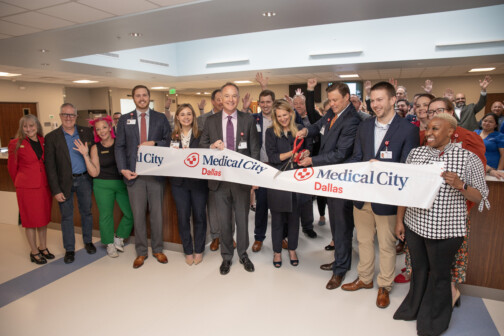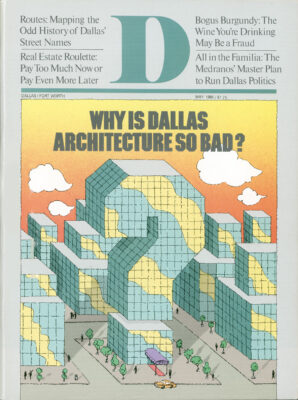If Houston works best as a skyline, Minneapolis is most impressive at street level – a compact, cohesive city with handsome parks and plazas, a broad pedestrian shopping mall, and a system of all-weather skyways that is being widely copied in Dallas and elsewhere.
“Minneapolis is superb as a totality,” says Weiming Lu, former head of urban design for the Dallas Urban Planning Department and now director of the Lowertown Redevelopment Project in St. Paul. “The scale is humane, there is a deep concern for history and context, and very little of the ’I’ll do my thing and you do yours’ attitude that one finds in many other cities. It’s possible to do planning here.”
In the late Fifties, business began abandoning downtown Minneapolis for the suburbs, much as Dallas companies would abandon Commerce and Main for LBJ a decade later. General Mills built its new corporate headquarters in nearby Golden Valley, and there were rumors that other large companies, such as Pillsbury, would soon follow. Major retail stores began moving to outlying shopping malls, claiming that downtown Minneapolis was doomed. The defections led to the formation of the Downtown Council, a private group made up of bankers, merchants, and corporate executives, whose sole task was revitalizing the inner city.
It did precisely that. In 1962 Northstar Center opened, one of the country’s first multi-use facilities. Although a mess architecturally, this warren of shops and offices topped off with a hotel, gave downtown Minneapolis an enormous psychological boost. Somebody was staying. In 1967 Nicollet Mall opened along a 10-block section of downtown, funded by the merchants, with the city acting as general contractor. Almost overnight, the mall gave residents a renewed sense of the possibilities of urban life. “We knew it was a success,” says Weiming Lu, “when the public objected to our running skyways over it. It had become their space.”
In 1969, construction began on the $135-million IDS Center, designed by Johnson/Burgee, which included a 51-story office tower, a hotel, a large department store, and many small shops and restaurants that faced a vast covered plaza called Crystal Court. Although the project was plagued by cost overruns, estimated at around $20 million, when it was completed in 1973, Minneapolis finally had a town square.
“IDS convinced us that we were big time,” says John Burg, the city’s director of urban design. “It is unquestionably one of Johnson’s best buildings. And it’s our municipal living room.”
Other projects completed about the same time as IDS were Gunnar Birkert’s futuristic Federal Reserve Bank, John Warnecke’s controversial Hennepin County Government Center, a giant pop up toaster with an atrium, and the widely acclaimed postmodernist Orchestra Hall designed by Hardy Holzman Pfeiffer.
At the present time there is an estimated $600 million in new construction in downtown Minneapolis, including Pillsbury Center, a Hyatt Regency Hotel, the $100-million City Center Project, and a four-block extension of Nicollet Mall. An elegant Richardsonian Masonic Temple has recently been converted into the Hennepin Center for the Arts. Along the Mississippi River, blocks of turn-of-the-century warehouses are being converted into shops, offices, restaurants, and studios.
Minneapolis is home for many national corporations, including 3M, Pillsbury, Honeywell, and Control Data, an important reason for the extraordinary degree of corporate involvement in municipal affairs. “It is the country’s most enlightened business community,” says city planner Tom Martinson, “usually far out ahead of the banks, the developers, even the architects, in matters of design and planning.” More than 40 Minneapolis companies belong to the “Five Percent Club,” meaning they give 5 percent of their pre-tax earnings to arts organizations and institutions, and social service programs.
Whether the Minneapolis model can be exported elsewhere is a matter of debate, but the extent to which other cities are studying it, including Dallas and Houston, suggests that it may be very adaptable indeed.
Get our weekly recap
Brings new meaning to the phrase Sunday Funday. No spam, ever.
Related Articles

News
Medical City Opens ER in Garland and Local Dermatologist Named Youngest Ever President of the American Academy of Dermatology
Plus Health Wildcatters wins accelerator competition and DFW Hospital Council Foundation awards.
By Bridget Reis

Business
Wicked Bold Chocolate CEO and Comedian Deric Cahill on Why it Pays to Be Funny
The brand leans into humor, but the business' success is no laughing matter, with products in nearly 2,000 retail locations nationwide.
By Will Maddox

D CEO Award Programs
Nominations Open: D CEO’s 2024 Corporate Counsel Awards
The annual program honors top in-house attorneys in Dallas-Fort Worth, from outstanding up-and-comer to outstanding general counsel.


